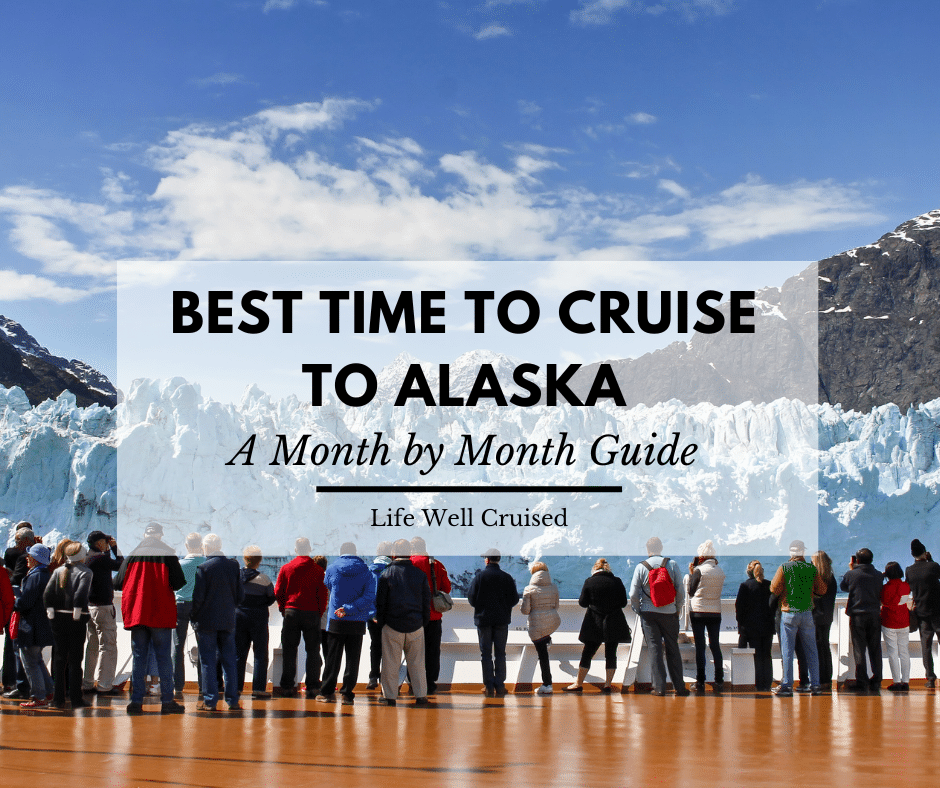
Choosing the best time of year for an Alaskan cruise can be challenging. From month to month, the weather, wildlife, and your chances of viewing the mesmerizing Northern Lights vary greatly.
Since I grew up in Alaska, I’m a fan of just about everything in the Land of the Midnight Sun. I also know that your experience can vary widely depending on the month you choose to visit Alaska.
Which raises the question…
When is the Best Time of Year to Cruise to Alaska?
The abbreviated Alaskan cruising season goes from May to September. Although you’ll find the highest number of travelers visiting Alaska during the peak cruising (and fishing) months of July and August, the ideal time for your Alaskan cruise depends most on your personal priorities.
In this post, I share a month-by-month guide about the best time of year for an Alaskan cruise. I’ve included tips on the weather, wildlife, daylight, and the general experience you’ll have each month of the Alaska cruise season to determine when to set sail for the 49th state.
Alaska Cruise Season
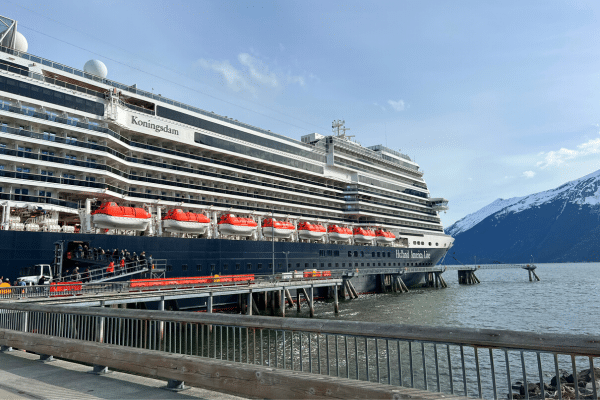
The cruising season to Alaska is shorter out of necessity. Weather, ocean conditions, and limited sunlight make winter cruising to Alaska impossible.
For major cruise lines, the Alaska cruise season runs between May and late September, including Viking and Disney.
Many cruise lines also have limited early cruise ships departing for Alaska in April. Norwegian Cruise Lines has the first departures of the season in early April from Seattle.
Holland America Princess, and Royal Caribbean have Alaskan Inside Passage cruises departing from Vancouver at the end of April. Carnival has 14-day Alaskan cruises departing from Seattle and Long Beach in late April.
This post contains affiliate links which means if you click and buy that I may make a commission, at no cost to you. Please see my disclosure policy for details.
As an Amazon Associate I earn from qualifying purchases.
Alaskan Cruise Month-By-Month Guide
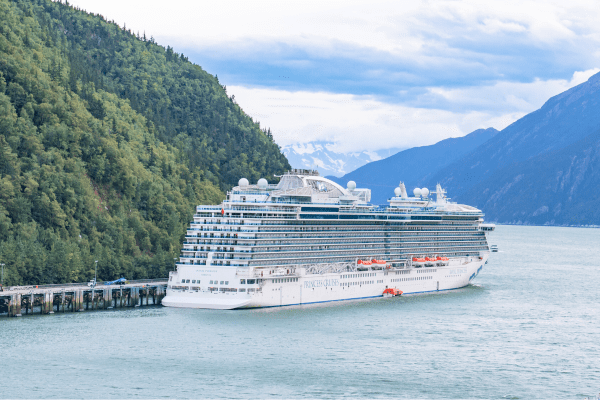
What to Expect on an Alaskan Cruise in April
Spring in Alaska is a unique experience. The benefits of cruising in April include less expensive pricing, fewer tourists, and less crowded ports. Here is a breakdown of other important considerations for an April Alaskan cruise.
Weather:
Locals typically call the months of April and May “break-up” because the snow and ice begin to break apart and melt after the long winter. What does this mean for tourists? Snow and mud! In April, mountains will still be snowy, and high temperatures will max out in the upper 40s for most cruise ports.
April marks the beginning of the dry season for Southeast Alaska. However, it’s important to remember that this area is part of the world’s largest temperate rainforest.
The average rainfall in Juneau during the month of April is 2.77 inches. Although the rain isn’t convenient, it is the reason for the lush vegetation you enjoy.
Be sure to pack high-quality rain gear for excursions along with warm, layered clothing and a hat and gloves. Many early spring cruisers also pack a winter coat.
Daylight:
Because of its latitude, Alaska experiences extremes in daylight in the summer and darkness in the winter.
On Winter Solstice (December 21 or 22), the state breaks out of its winter hibernation and begins gaining a few minutes of sunlight each day. By the time Summer Solstice occurs (June 20,21, or 22), travelers to Juneau, Alaska, a common port, will experience a day with 19 hours of sunlight.
In April, towns along the Inside Passage will have just over 15 and a half hours of sunlight and will be gaining daylight every day.
Since the skies do still get dark during this month, there is a slight chance that you’ll be able to view the Northern Lights on an Alaskan cruise in April. Peak viewing of the Aurora Borealis happens between November and March, but on a clear night with lots of solar activity, you have a shot at this once-in-a-lifetime viewing experience.
When it comes to Alaskan cruises, balcony cabins come at a premium. You can save money by opting for an inside or an oceanview cabin. However, the views and ability to go sightseeing from your room on ocean days make the higher price worth it.
If you purchase a balcony cabin, you can take advantage of the long days in the Land of the Midnight Sun. As your ship reaches the Inside Passage, the early morning views outside of your room are breathtaking.
Wildlife:
There are plenty of animals to see while cruising to Alaska. Arguably, the biggest draw is the marine animals, with opportunities to see pods of humpback whales, gray whales, orcas, sea lions, sea otters, and more.
There are also amazing birds, including bald eagles and land animals like mountain goats, Dall sheep, and brown and black bears.
Although gray whales are more elusive than their humpback cousins, April is your best chance to spot them as they migrate from their winter breeding grounds in Baja, Mexico, to feed in the waters inside the Interior Passage of Alaska.
Orca whales (which are actually members of the dolphin family) are a fairly common site on an Alaskan cruise. “Resident” orcas (who stay near shore and feed on fish) are easy to spot and fun to watch from the cruise ship or on a whale-watching excursion.
General Experience:
Choosing to cruise in the early spring of Alaska will impact your experience. Less travelers might sound appealing, but many port towns aren’t fully “tourist operational” until late June when summer workers start to arrive.
An April sail date is one way to save money on your Alaskan cruise. Just expect cooler weather, fewer wildlife viewing opportunities, and less active ports with some shops that are still shuttered.
Related: What to Pack for an Alaska Cruise (clothing, gear & essentials)
What to Expect on an Alaskan Cruise in May
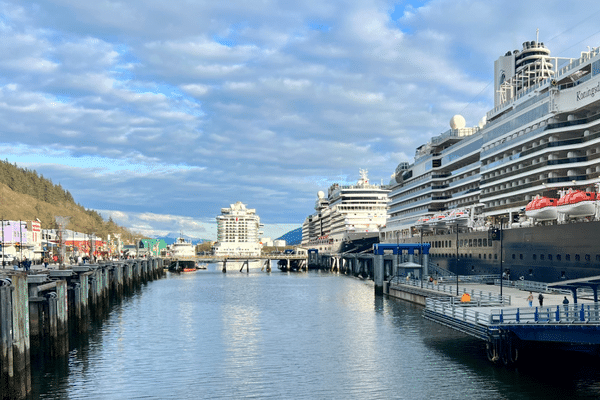
Cruising to Alaska in May is still considered early in the season. As the month progresses, temperatures rise slightly, and daylight hours increase.
While prices in the early season are generally less expensive, your experience during a May cruise will look different from during the high season in July and August. Here is what you’ll find in Alaska in May.
Weather:
Alaska will still be emerging from winter during May. The high temperature in May in the capital city of Juneau, averages in the mid-50s, with lows in the 40s.
In most Alaska ports, rainfall occurs about 15 days of the month. You’ve got about a 50/50 chance of getting rained or snowed on during excursions. You’ll be very happy if you purchase a quality raincoat and pack clothing you can add or remove in layers.
A hat, gloves, and a winter coat would be a good idea to pack for an Alaskan cruise, especially if you depart in April, May, or September.
Daylight:
Alaska is still gaining sunlight as the Summer Solstice approaches, so you’ll experience longer days during your May cruise.
At the beginning of the month, sunrise in Juneau begins at 5:00 a.m., and sunset is at 8:47, resulting in 15 hours and 47 minutes of daylight. As May closes, the days are even longer, with the sun rising in Juneau at 4:00 a.m. and setting at 9:49 p.m. (almost 18 hours of daylight!).
Wildlife:
Another thing to keep in mind when deciding the best month for your Alaskan cruise is wildlife viewing opportunities.
Salmon usually begin their long journeys home to spawn in May, but they come in different waves or “runs.” You might have a chance to view bear feeding on salmon this early in the springtime, but your chances are better later in the summer.
There are exciting marine animals that you can see this early in the Alaskan springtime.
Alaska’s Stellar sea lions are an impressive sight for cruisers. Because they don’t migrate, you have a great chance of viewing these 1000+ pound, 10-foot-long animals on rocks near the shorelines as you cruise. Be sure to listen for their signature roar.
There is also potential for viewing orcas, gray whales, and walruses.
May is an excellent cruising month for birdwatchers as migratory songbirds start to arrive in Alaska and seabirds gather in their nesting spots or rookeries. Keep an eye out for my favorite, the ever-adorable puffins, Arctic terns, cormorants, and bald eagles.
General Experience:
May is a practical choice for Alaskan cruisers who are on a limited budget but want to have slightly warmer and drier weather and more chances to see wildlife. Your views will likely include snowy mountains, but they are gorgeous nonetheless.
Expect less activity and fewer shop openings in some smaller port towns in May since most summer workers are in college and won’t arrive until June.
What to Expect on an Alaskan Cruise in June
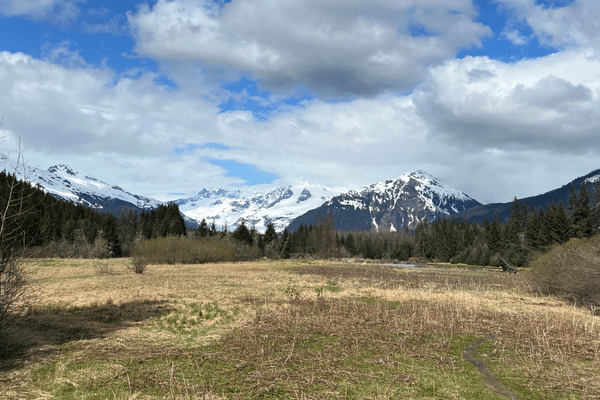
Things start hopping in Alaska in June. Summer workers (typically college students) begin to arrive for the peak tourist season, and shops and restaurants open for the summer.
As the temperature warms up, the snow on the ground in port towns melts, and more wildlife begins emerging from their winter dens.
Because school is often still in session for younger children in May and June, taking an Alaskan cruise in the early Spring/Summer is a good choice if you prefer fewer children on board.
Weather:
In the Lower 48, temperatures in June start to heat up, not so much in Alaska.
While temperatures are warmer and the snow is typically gone at lower elevations, the highs in Juneau average in the low 60s, with lows in the upper 40s.
Temperature is relative, so don’t be shocked if you see an Alaskan sporting shorts and a tank top in June. The 60s can feel downright tropical after winter temperatures in the 20s and 30s.
Rainfall slows down a bit in June, with about 13 days of the month having some precipitation.
Packing-wise, you’ll still want to bring a raincoat, but you can probably leave your winter coat home if you are cruising in June.
Daylight:
It is remarkable to experience Alaska on or around the summer solstice. The amount of daylight increases as you travel northward, but even Juneau’s 19-hour solstice day, with the sun rising at 3:48 a.m. and setting at 10:09 p.m., is a fantastic experience.
If you are in port, you’ll get to see how Alaskans take advantage of the Midnight Sun with locals out biking, hiking, and fishing at all hours of the night.
You’ll also have more hours to look for wildlife from your room window or veranda.
If you have an exterior room and are sensitive to light while sleeping, a sleeping mask will help you rest during these long days.
Wildlife:
Humpback whales are the most commonly seen whale in Alaska. They begin migrating from Hawaiian waters in the springtime to feed in the nutrient-rich Alaskan waters.
While it is possible to see humpbacks during the entire cruise season (April-October), your best bet for whale watching will be the months of June, July, and August. They are quite an awe-inspiring sight to see as they travel in pods, breech, and feed.
This is also the time of year when King Salmon runs both begin and end. If you are an angler, there is nothing like hooking and reeling in a King. With an average size of 24 to 36 inches and weighing 10-50 pounds, you’ll finally have a true fishing story worth telling.
General Experience:
If you cruise to Alaska in June, you can expect warmer and drier temperatures, fewer children onboard, increased wildlife sightings, and more cruise offerings.
June is a smart choice for cruisers who don’t want to travel during peak season but want more opportunities.
Related: What to Wear on an Alaska Cruise (outfit ideas with photos)
What to Expect on an Alaskan Cruise in July
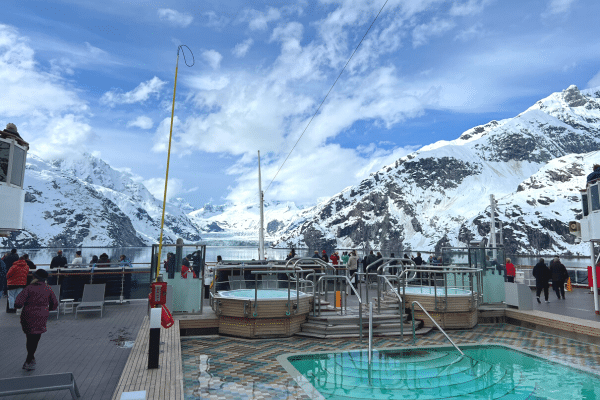
Weather is a pretty big consideration when it comes to booking an Alaskan cruise. Temperatures can be quite chilly on deck and in ports of call. If you have a low tolerance for cold weather, cruising Alaska during the warmest months of July and August is a better choice.
July and August are considered peak seasons to cruise to Alaska for good reason. These are the months when all good things combine to create the optimal Alaskan experience.
That being said, the weather and wildlife in Alaska are notoriously unpredictable. You could book a cruise in July and never get above the 50s. You might take a float plane to see bears and, sadly, not see a single one.
My advice is to pack plenty of warm (and waterproof) layers, expect the unexpected, and find joy in whatever experience you get.
Weather:
The weather in July only trends slightly warmer than June. The average July temperature in Juneau is 64 degrees, with an average low of 51 degrees.
The dry season ends, and precipitation starts to increase in July. Rain falls on average 14 days of the month. Just remember our earlier reminder that you are visiting the world’s largest temperate rainforest and enjoy the lush greenery.
Daylight:
After the Summer Solstice in June, Alaska begins losing daylight with each passing day. While the days are still longer than those in the Lower 48, they are getting slightly shorter throughout July.
In Juneau, the sun rises at 3:54 a.m. at the beginning of July. By the end of July, it starts rising at 4:45 a.m.
Sunsets move to earlier in the night as the month progresses. The sunset on July 1 in Juneau is at 10:07 p.m., and by the end of July, it is at 9:21 p.m.
Although it is getting darker earlier, solar activity is not at its peak in the summer, so your chances of viewing the Northern Lights in July are slim to none.
Wildlife:
July is a spectacular month for viewing wildlife in Alaska. Not only are humpback whales, orcas, sea lions, eagles, and seabirds easier to see as they feast in the nutrient-rich summer waters, but the likelihood of seeing the indomitable Alaskan brown, black, and Kodiak bears increase as they focus on fattening up on migrating salmon.
Small-ship Alaska cruise lines like American Queen Voyages and Uncruise can go further into narrow passages and get closer to shoreline wildlife like Dall sheep and bears.
If bear viewing is high on your bucket list and you are traveling on a bigger cruise ship, look for a float plane excursion that will take you to where the bears feed.
General Experience:
July is filled with opportunities to see the stunning wildlife of Alaska while enjoying milder temperatures.
July also brings the highest number of tourists to Alaska. If you cruise to Alaska this month, you can enjoy more shop and restaurant options in port towns but expect things to be slightly more crowded.
What to Expect on an Alaskan Cruise in August

August is a delightful time to cruise to Alaska. You’ll enjoy wildlife viewing, warmer temperatures, and daylight returns to more typical hours. However, the dry season has ended, so rainfall will begin to increase as the month progresses.
Weather:
For cruise itineraries in Alaska, August high temperatures will be somewhere in the upper 50s and low 60s. We’ve reached the pinnacle of summer temperatures, and the rainier season has just begun.
Juneau gets about 17 days of rain in August, so a high-quality raincoat is essential.
With lows in the 50s, you don’t need to pack a winter coat and hat, but be sure to include warm, wicking layers to keep your temperature steady.
Daylight:
By the end of August, the sunrise and sunset times in Alaska are pretty close to “normal” times for most states in the USA. You might feel like you aren’t getting the true Alaskan “Midnight Sun” experience this month.
In Juneau, on August 31, the sunrise is at 5:52 a.m., and the sunset is at 8:01 p.m.
The loss of daylight does mean you could see the Aurora Borealis while cruising to Alaska in late August. The best time to see the Northern Lights is between late August and April, typically peaking in March.
Unfortunately, seeing this supernal show of sun activity is not a given. Overcast skies are common in Alaska and block the Lights, and the solar activity that creates the phenomenon is unpredictable. You can increase your chance of seeing the Northern Lights by asking crew members if you can get placed on a list that will be notified when, as we say in Alaska, “the lights are out.”
Wildlife:
In August, the wildlife can sense that winter is on its way, and activity picks up to prepare for the months of cold, snow, and darkness.
You might see bears that are continuing to fatten up before hibernation. Humpback whales have yet to begin their migration to warmer waters, so you will still be able to see them, especially in early August.
Seabirds will still be feasting on fish. You also might see fuzzy harbor seal pups and sea lion pups (born in June and July) warming themselves on rocks with their mothers. Add high-powered binoculars to your Alaska packing list to ensure that you get to see all of the wildlife possible.
General Experience:
You can’t go wrong with a cruise to Alaska in August. Not only is it your best shot for warmer weather, but you’re also sure to see a good amount of the wildlife Alaska is famous for.
Warmer weather in Alaska also has an unexpected bonus for cruisers in the form of glacial calving.
Glaciers are a natural wonder that no photographs can do justice. Until you have experienced the majesty of an ancient river of ice in an unparalleled blue, it is hard to imagine!
Every Alaskan cruise includes at least one glacier viewing stop. The warmer the weather, the better your chance to view a once-in-a-lifetime occurrence called “calving.” This is when a large chunk of the glacier separates in a giant icy landslide.
Not only is the cracking sound shocking, but the calving also produces a giant wave of water and captivating icebergs. July and August are prime time for viewing glacier calving on an Alaskan cruise.
What to Expect on an Alaskan Cruise in September

April, May, and September are considered shoulder seasons for cruising to Alaska. Shoulder season is the time between peak season and off-season when there are fewer cruisers and lower prices.
A September cruise has its benefits, including less crowding and cheaper prices. However, a cruise this time of year will also slightly decrease your chance of viewing wildlife and make for sleepier ports of call because most summer workers return home for college.
Weather:
In Alaska, we measure the return to winter by how far up the stalk Fireweed flowers have bloomed. By September, the blooms are most certainly to the top as winter rapidly approaches.
High temperatures in September in Juneau hover around the upper 50s with lows in the mid-40s, though, so it is still an enjoyable time to visit.
Precipitation increases to 19 days of the month, so pack a raincoat with a hood (you’ll be grateful to have it!).
There is a chance you will see some snow, so a winter coat, gloves, and a hat are a smart addition to your packing list.
Daylight:
In September, the scale now tips towards later sunrises and earlier sunsets in Alaska. By the end of September, there are less than 12 hours of daylight in Juneau.
Cruising in September will give you the highest chance of viewing the Aurora Borealis on an Alaskan cruise. You won’t want to miss this indescribable sight, so watch for clear night skies and set an alarm to go on deck (or on your balcony) for potential middle-of-the-night Northern Lights shows.
Wildlife:
Gray whales and Humpback whales begin their migration to warmer waters in October and November, so you still have a chance to see them in Alaskan waters in September.
Birds also haven’t started their migration, so you can spot both songbirds and seabirds as you cruise along the coast.
Silver salmon runs are possible in September, but not a guarantee.
September is also an excellent time to witness a towering Alaskan moose. By this time of year, bull moose have a full rack of antlers. With shoulder heights at 6 foot 9 inches and over 1,400 pounds, these massive animals are as dangerous as impressive, so you’ll want to view them from a distance.
General Experience:
Cruising to Alaska in September has many benefits of the peak season (milder weather and good wildlife viewing) with less expensive prices and fewer tourists.
Although the weather will likely include more rain, you have a better chance of viewing the Northern Lights, which might outweigh this drawback.
If your itinerary includes stops in Anchorage, Seward, or Whittier, you might experience rougher seas as you cross the Gulf of Alaska in September.
FAQs About Alaskan Cruises
What is the best time of year to see the northern lights on an Alaska cruise?
The peak season to view the Northern Lights or Aurora Borealis is between late August and late April, which unfortunately doesn’t overlap much with the Alaskan cruise season. If the Northern Lights experience is high on your Alaska bucket list, consider a September cruise with more dark nighttime hours and increased solar activity.
How far in advance should you book an Alaskan cruise?
If you are hoping to travel during peak Alaskan cruise season (July and August), you should plan on booking your Alaskan cruise at least one year in advance. The farther in advance you can book your Alaskan cruise, the more options you will have for cruise dates, itineraries, and cabin amenities.
Are the seas rough on an Alaskan cruise?
When traveling from Vancouver in the Inside Passage of Southeast Alaska, the waters are mostly protected and provide smooth sailing. If ports include Anchorage, Seward, or Whittier, cruise ships must cross the Gulf of Alaska, which has notoriously rougher waters. This is especially true after Labor Day.

Popular & Related Posts
- 50+ Must-have Cruise Essentials from Amazon
- 13 Alaska Cruise Mistakes that Can Ruin Your Cruise
- What to Pack for an Alaska Cruise (clothing, gear essentials)
- 17 Best Things to Do in Juneau Alaska Cruise Port – Complete Guide
- 20 Best Things to do in Skagway Alaska Cruise Port – Complete Guide
- What to Wear on an Alaska Cruise (outfit ideas with photos)
Final Thoughts on the Best Time of Year for an Alaskan Cruise
Peak cruising months, July and August, are the best time of year to cruise to Alaska. During these months you will have the warmest weather and the greatest chance to see wildlife.
If you want to see the Northern Lights, September is the best option for your cruise to Alaska, although sightings are not guaranteed.
Are you thinking of taking an Alaska cruise? Please let me know in the comments below.
Happy Cruising!
If you found this article helpful, please pass it along. Please feel free to share on Facebook or PIN to your favorite Pinterest board (share buttons at the top). Thanks so much!
Author Bio:
Stephanie Yrungaray grew up in gorgeous Eagle River, Alaska and now calls Utah her beUtahful home. She enjoys traveling and exploring with her husband and five kids any way she can, from cruising to RV camping and everything in-between! When she’s not out exploring, you’ll find her writing about travel, finances and parenting as well as gift ideas on her website, www.TheGiftyGirl.com.